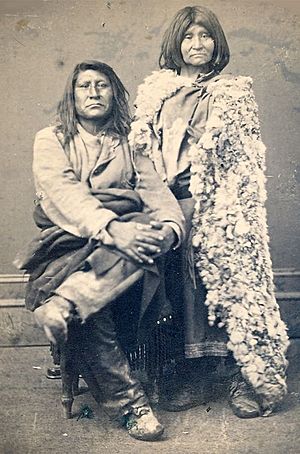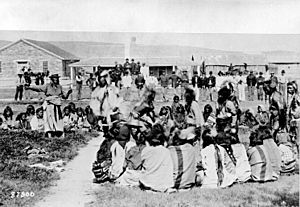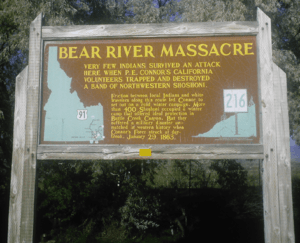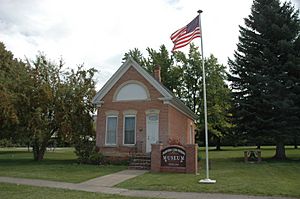Sagwitch facts for kids
Quick facts for kids
Sagwitch Timbimboo
|
|
|---|---|

Chief Sagwitch and spouse Beawoachee
|
|
| Northwestern Shoshone leader | |
| Personal details | |
| Born | 1822 On the lower Bear River (today's Box Elder County, Utah) |
| Died | March 20, 1887 Washakie Utah |
| Known for | Survived the Bear River Massacre; settled Washakie, Utah |
| Nickname | "Orator" |
Sagwitch Timbimboo (born 1822, died 1887) was a very important leader of the Northwestern Shoshone people. His name means "Speaker" or "One Who Writes on Rocks." He was one of the few people from his tribe to survive the terrible Bear River Massacre in 1863. This event was a huge loss for Native American people.
Chief Sagwitch bravely led his people during this attack by the United States government. Even after losing many of his people, Chief Sagwitch helped his tribe grow strong again. He lived most of his life in Cache Valley, an area in Utah and Idaho. He was a key leader for both the Shoshone tribe and The Church of Jesus Christ of Latter-day Saints.
He helped build a temple in Logan, Utah. After joining the Church in 1873, he became an Elder, a church leader. About 100 other tribe members also joined the Church with him. Chief Sagwitch died in 1887. He is remembered as a very important person in the Indigenous community.
Contents
Sagwitch's Early Life
Chief Sagwitch was born with the name Sagwip in 1822. He lived a traditional Northwestern Shoshone life. This meant his people hunted and gathered food. They lived off the animals and plants around Bear Lake and the Bear River.
When he was young, Sagwip went through his first Shoshone initiation. This included rolling in the snow without clothes. He was very good at hunting and making weapons. He learned these skills faster than most children in his tribe.
Becoming a Leader
By 1840, Sagwitch had two wives. He had many responsibilities in his family camp. Because he was such a talented speaker, his name was changed to Sagwitch. This name means "speaker" or "orator."
White American hunters had been in the area for years to trade. But in 1847, more white settlers started arriving. This led to a big increase in the animal fur trade. Sagwitch joined this business. He hunted animals like black bears and bison for their furs and meat.
In 1847, Sagwitch and other Shoshone leaders traveled to Salt Lake City. They met with leaders of The Church of Jesus Christ of Latter-day Saints, including Brigham Young. They learned that these settlers were moving west because of their religion.
In 1855, members of the Church settled in the Cache Valley area. When they arrived, life changed a lot for Sagwitch and his tribe. The settlers began to live all over Cache Valley. This made it harder for the Shoshone to gather food, graze animals, and hunt. The white settlers and the Shoshone tribe did not always get along. Natural resources in the area became harder to find.
The Northwestern Shoshone Tribe
The Shoshone tribe, also called the Shoshoni people, has a long history. They lived in the Great Basin region. This area covers parts of Nevada, Utah, Idaho, and Wyoming. Many different Shoshone tribes and families lived across this land.
The Western Shoshone people lived in small family groups. They were spread out across the area. Their way of life included gathering plants and hunting animals. The Bear River and Bear Lake were very important for their food and water.
The Shoshone sometimes fought with other tribes. These included the Blackfoot and Lakota. After white settlers came to the area, many Shoshone people died. They died from sickness and from different fights.
The Bear River Massacre was the worst single loss for the Shoshone tribe. About 250 to 400 men, women, and children were killed or hurt. After the 1800s, Shoshone groups started to get smaller. Many joined other groups or died out. Today, there are about 6,000 Shoshone people.
The Bear River Massacre
In the late 1800s, white settlers and members of The Church of Jesus Christ of Latter-day Saints moved west. They settled in what is now Utah and Idaho. As they explored northern Utah, they met the Northwestern Shoshone more often.
Local tribes had lost some of their hunting lands to the new settlers. They also faced starvation because of very cold winters. Because of this, they sometimes took crops and cattle from small farms. These farms were in Cache and Franklin counties, which is now Cache Valley.
On January 29, 1863, Chief Sagwitch Timbimboo and his tribe were attacked. This happened near Franklin, Idaho, in what is now Preston. Sagwitch was lucky to survive the Bear River Massacre. He had some painful injuries but they were not life-threatening. Sadly, his wife died during the attack.
About 300 people were killed or injured in the massacre. A group of volunteer soldiers from California carried out the attack. Their leader was Colonel Patrick E. Connor, an experienced soldier.
Sagwitch's Family Life
In the late 1830s, when he was a teenager, Sagwitch married his first wife. Her name was Egyptitcheeadaday, which means "coyote niece." In 1840, at age 18, Sagwitch married his second wife, Hewechee. Her name means "mourning dove." Even at a young age, Sagwitch had enough land and hunting resources to support two wives.
In 1846, his first wife, Egyptitcheeadaday, had a son named Tuinipucci. He was also called Soquitch. He was Sagwitch's first child to live to adulthood. In 1848, Sagwitch and his second wife, Hewechee, had a second son named Taputsi, who was later renamed Yeager.
In 1861, his wife Dadabaychee had another son named Beshup. Beshup became known as Timbimboo, which means "one who writes on rocks." This name later became the last name for Sagwitch's family. His second wife, Hewechee, died in 1862. His first daughter was born to his third wife, but her name is not known.
During the Bear River Massacre, Dadabaychee, his third wife, was killed by the Army. Soon after the massacre, Sagwitch married a woman named Wongosoff. She died while being held captive by the Army. In 1865, Sagwitch married his fifth wife, Beawoachee. She was his only living wife at that time.
Frank W. Warner, born Pisappih "Red Oquirrh" Timbimboo, was raised by another family after his mother was killed in the massacre. Sagwitch also had a grandson named Moroni Timbimboo. While Sagwitch and his wives may have had other children, there are no records of them living past their teenage years.
Church Service
In 1873, Sagwitch was baptized and became a member of The Church of Jesus Christ of Latter-day Saints. George Washington Hill performed the baptism. About 100 other people from Sagwitch's group were also baptized into the Church.
Sagwitch later received the priesthood and was ordained an Elder. In 1875, Sagwitch and his wife were sealed for "time and all eternity." This special ceremony was performed by Wilford Woodruff in the Endowment House.
Frank, Sagwitch's son, became one of the first Native Americans to serve as a missionary for the Church. Sagwitch's grandson, Moroni Timbimboo, was the first Native American to serve as a bishop in the Church.
Sagwitch and his family also helped a lot with building the Logan Utah Temple. In 1880, Sagwitch and his group settled in Washakie, Utah. They ran a small church farm there. Today, Washakie is a ghost town, empty and uninhabited.
Camp Sagwitch
Chief Sagwitch and his small group of Shoshone Indians often moved around Cache Valley. They did this to find food and other resources. The tribe liked to camp in a small area near Paradise, Utah.
Chief Timbimboo's group visited this area so often that local settlers started calling it "Sagwitch Basin." Sagwitch Basin is in the southern part of Cache Valley. It is located near what is now Porcupine Reservoir.
The name Sagwitch Basin became popular with people in the small towns of Paradise and Avon. Boy Scouts, church groups, historians, and others have made it a tradition to hike the steep mountainside. They camp overnight where Sagwitch and his people once found safety.
One local group of performers has even taken the name. "The Sagwitch Basin Boys" are made up of three friends and a father-daughter duo. They perform western ballads and folk songs at the yearly Mountain Man Rendezvous in Cache Valley.
Regular rendezvous and fur-trading posts were very important for early settlers and Native Americans. Semi-nomadic tribes like the Northwestern Shoshone relied on these gatherings. They could get new supplies during hard times. Guns, ammunition, horses, metals, and other valuable items were available at events like The Rocky Mountain Rendezvous. Each spring, people from Cache Valley and beyond come to experience moments like those shared by fur traders and the Shoshone Indians.
A book about Sagwitch was written by Scott R. Christensen. It is called Sagwitch: Shoshone Chieftain, Mormon Elder, 1822-1887. Utah State University Press published it in 1999.




